Montelaterone
Maremma's Watership Down
Montelaterone near Arcidosso is Maremma's Watership Down. A medieval labyrinthine hill top village that will lead you in circles of an afternoon. Set off a game of hide and seek with your kids and you may not see them for hours, but they will you!
I can wander for hours in the concentric streets of the many wonderful walled medieval hill top villages and towns in this undiscovered part of Tuscany, with their narrow up and down and alleys linking one level with another, photographing their details and not loose my bearings. Normally that is.
But Montelaterone is different. It isn't bigger or smaller than most. Nor busier or quieter. But it has a lot of ups and downs. That split in two. And interconnecting, dark, arched alleys that split them. Which, if you are busy photographing and trying not to wake a sleeping cat of an afternoon can, pleasantly, lead you in repeating circles.
Especially if - as was the case when I visited one Sunday afternoon - a theatre company is filming in one of it's tiny piazzas (which, apparently they are apt to do often) that joins two "main" runs and you are "asked" - shaking heads and pointing fingers will be involved - to find an alternative route. Which will lead you in another circle!
Back to the bar. Always back to the bar.

Everything is in order in Montelaterone. Its labyrinth was designed centuries ago to be the way it is. And everyone who lives there knows where their burrow is and keeps it in good order. With tended greenery and flowers potted, hanging here and there. It is just that if you are a new "bunny" in town you might find yourself unexpectedly becoming good friends with the four ladies that run the bar come mini shop, come village meeting place. Which I kind of like to think is how this warren was meant to be.
And there is a little story behind that bar that sets an example to other tiny towns in Tuscany that are struggling to stay alive.
 How thin is your house?
How thin is your house?
Send your kids off in front of you and see how many times they can manage to jump out in front or behind you by tracing paths around you!
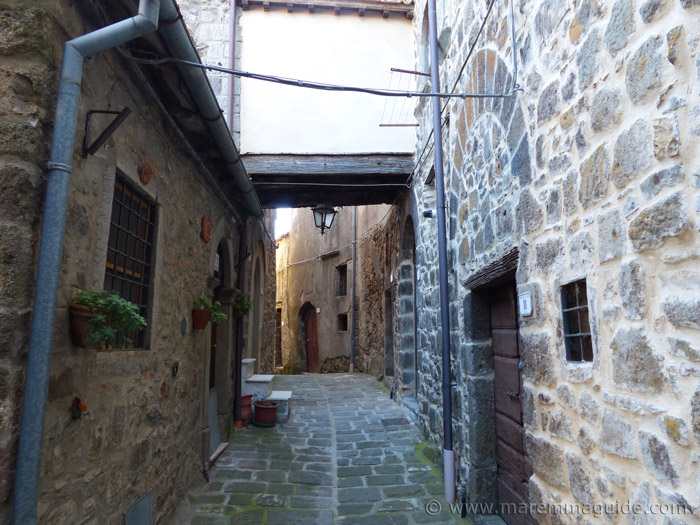
Via delle Mura.


Just one of Momtelaterone's sleeping cats. But, even curled-up with her eyes closed, she knew I was there and raised her head, oh just so slightly to check this English woman out. saw nothing of interest (I perfer to think of concern!) and went back to dosing. As cats do.
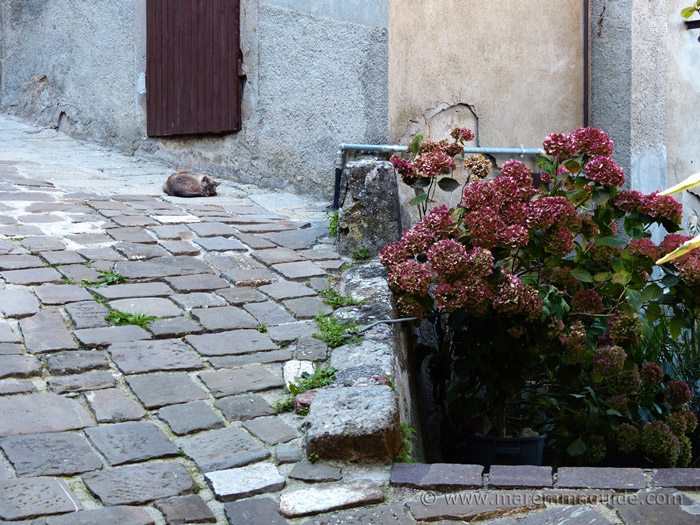
A rather handsome house with hydrangea-filled watering cans attached to its walls.

Next door's thin house has been restored and is waiting on the finishing touches... windows and the like. Word has it is is for sale.

Spot that stone at the foot of this imposing green door? It won't be the only one you will see in town; in fact you will be forgiven for thinking that it makes it's rounds of town when you aren't looking as there are a few cut exactly the same. Each doing the same job of blocking a square-cut hole.
I'm guessing once the passageway for the palazzo's best mice-catcher, who is probably now much too well fed and round to get through.
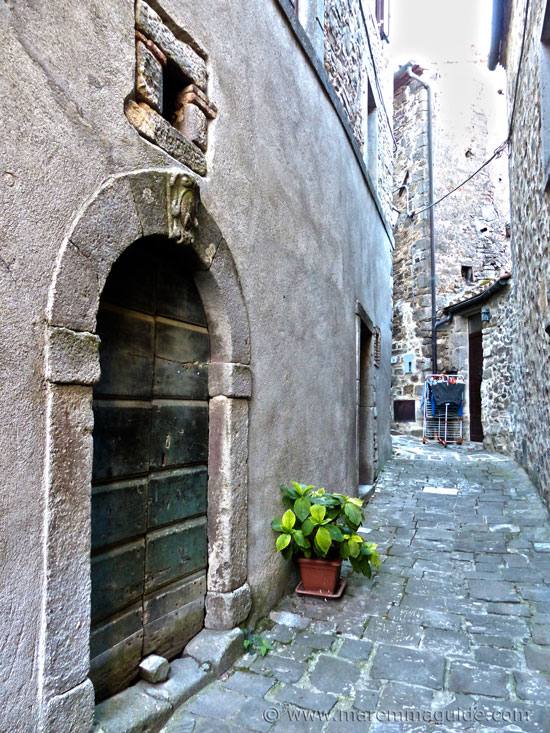

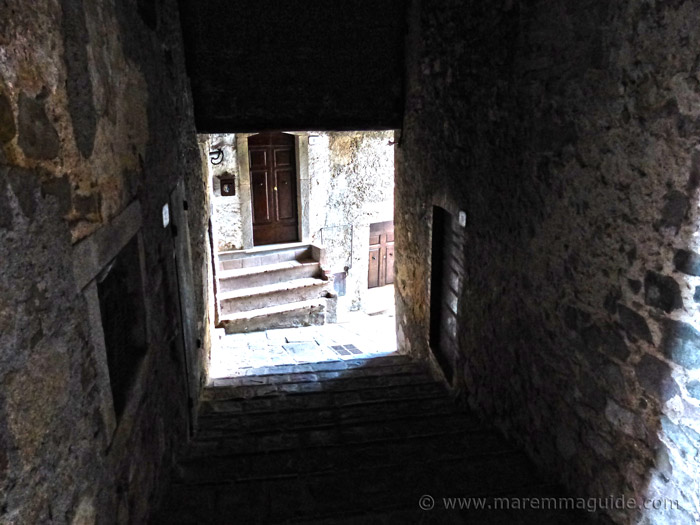

Below, to the left in the dark, under the arch past the brown front door, is another alley connecting two parallel streets.
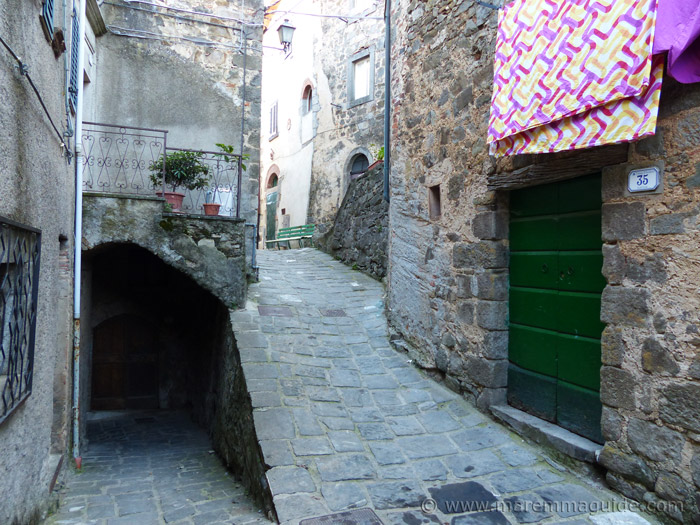
There's that stone again!

And another tiny street again going down to the left past another brown front door.

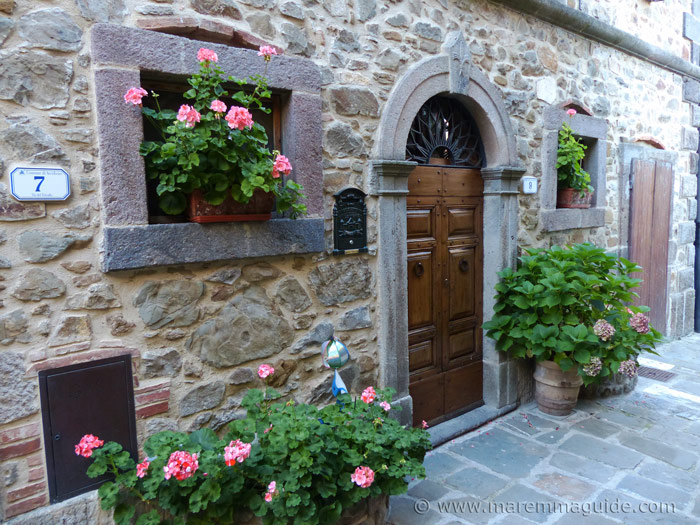
The greenest alley in town: not much light gets down there.
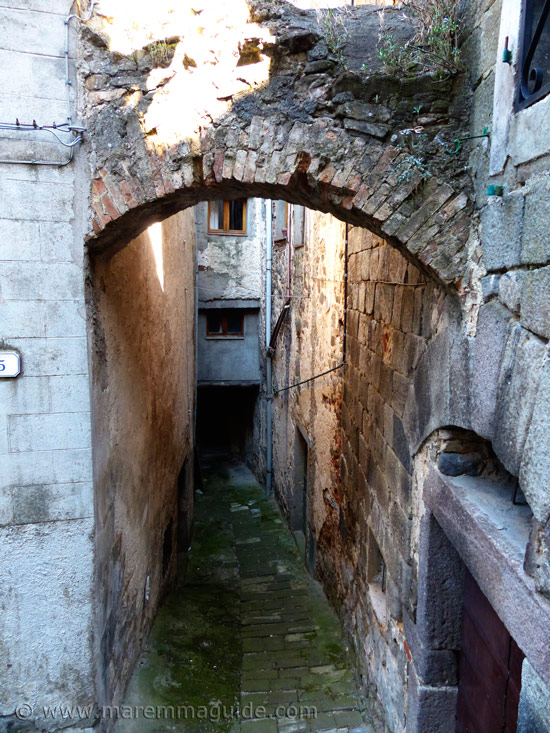
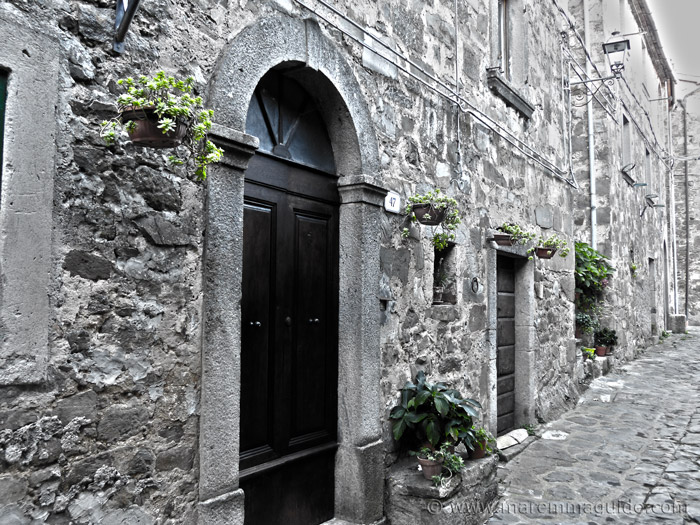
Just a couple of dandelions remaining down this zig-zag of a run.


This cobbled street is steep and still has its original rows of blocks set on end to help stop horses from slipping.
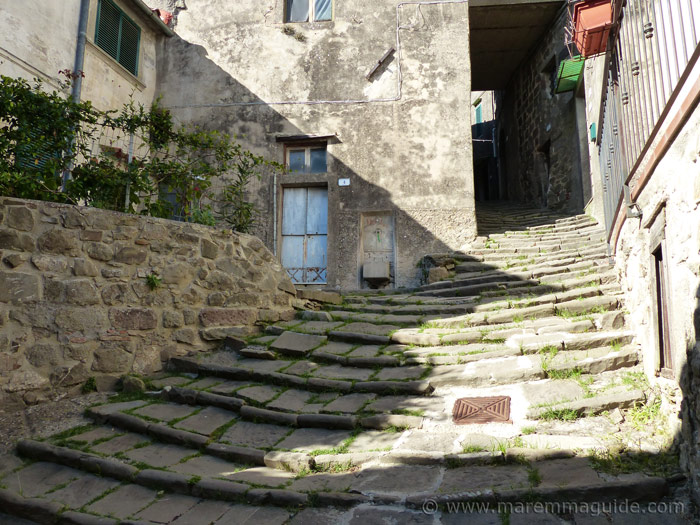
Montelaterone's history
The first inhabitants of Montelaterone originally lived in a village around the church - that you shouldn't miss visiting - at the bottom of it's hill, the Pieve di Santa Maria ad Lamulas. Where they had lived a rather pagan existence.
But when, at the very beginning of the 11th century, the monastery that owned the village, huge swathes of the land, other towns and the cinnabar mines around Monte Amiata - the Abbazia del SS. Salvatore (The Abbey of San Salvatore) - decided that circumstances warranted a fortified village, they built the Montelaterone's defensive double walls, gateways through them and the first buildings inside.
The parishioners had little choice but to move up the hill. And their village below, sited on a magical water source, was abandoned. By 1070 all but a few remained living in what was left.
Up into another alley "nel buio", this time under a building and requiring not one, but two ninety-degree turns to traverse it. Passing some front doors always in the dark along the way.
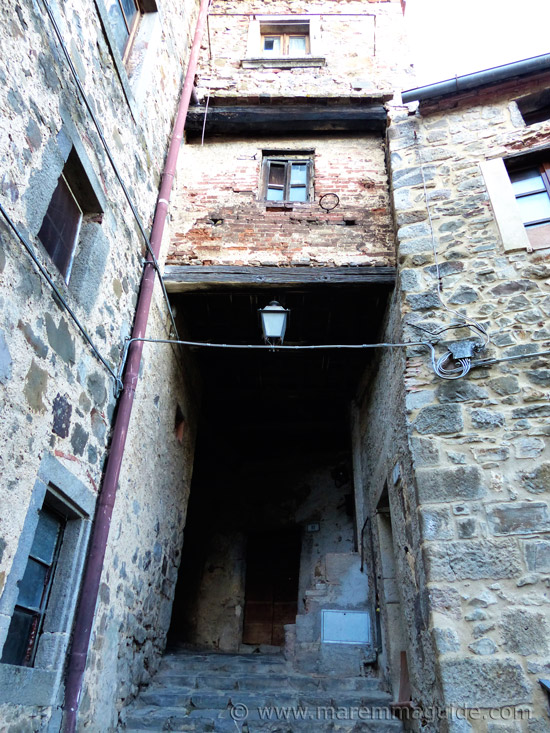

The Circolino la Brizza
In Piazza del Popolo - the main piazza in town near the church Chiesa di San Clemente - you will find the "Circolino la Brizza". The local bar and events venue.
But those words really don't convey just what it is. It is a bar. But it is more than that.
Sometime ago it used to be the most popular bar around for miles, not because of its coffee. But because it was owned and run by a woman whose personality and joviality made folk want to drive on up the hill and park their Ape, jeep or car and take their breakfast, morning break, after lunch cafe and pre going home dinner sip, there. With her. For her company and the atmosphere. Every day.
Then she died. And the bar closed, and stayed closed.
And Montelaterone died a little.

No one wanted to open a bar in a quiet village. Too many expenses and little income.
The locals took to drinking their coffee in various other places, scattered around Arcidosso and Castel del Piano. Village kids ceased gathering there of an afternoon. Teenagers took to their motorino's where they could, or got mum and dad to taxi them the four kilometres down the road into Arcidosso.
And Montelaterone died some more.
But four local women decided to do something. Together. They knew that a bar on it's own wouldn't survive, even if they could make it the happy place it once was. And they didn't just want to serve drinks and snacks. They had grander ambitions. They wanted to reverse the decline of locals coming into the centre to meet and chat and pass the time of day, as they had for centuries.
And they wanted to put some life back into Montelaterone.
So, with a plan, they opened Circolino la Brizza. A bar, yes. But also a mini-store and deli with freshly baked bread. With the essentials that we always run out of at home, on the doorstep - literally - of everyone in town. Who could pop down in their slippers to get what they needed. And they do. Including toilet roll!
Every afternoon their counter becomes the place for local children to choose their afternoon "merenda" (snack) and stay and play and chat together.
And they did something that started a crescendo. They set out to hold a calendar of artistic events throughout the year. Which people liked. Came to see. And talked about.
A theatre company set up base there.
Local home owners opened their doors and homes free of charge to visual artists from Paris and Hamburg - including painters and Parisian sculptors - as studios for them to create in. In exchange for an original piece of art made by the artists whilst they were with them. How wonderful!
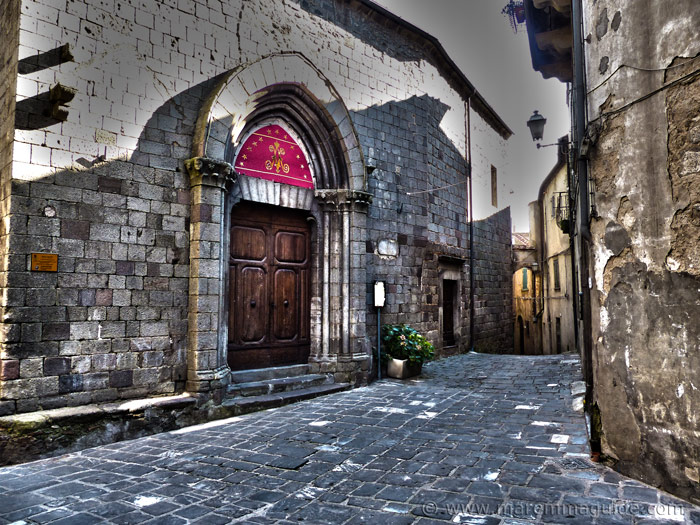 The 1302 church of Chiesa di San Clemente.
The 1302 church of Chiesa di San Clemente.
Visitors came to see art being created and stopped a while. Drank wine, talked, laughed and told their friends.
International artists came, saw and liked Montelaterone. And stayed.
It was just the start. The word spread and the second two week exchange of art for a place to create in town, surrounded by the incredible natural beauty of Maremma, attracted more artists. . And for two weeks in the month of October, the village was abuzz.
The fear that Montelaterone would become a ghost village has gone.



Even knomes have started to set-up home there ;)
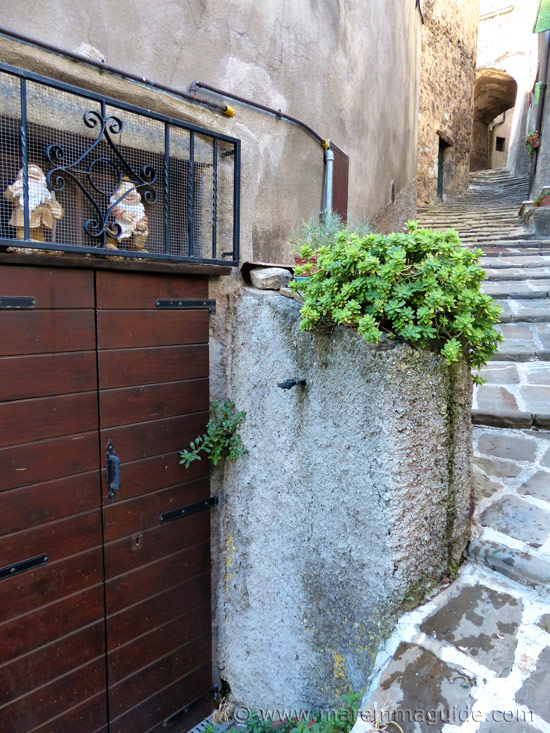
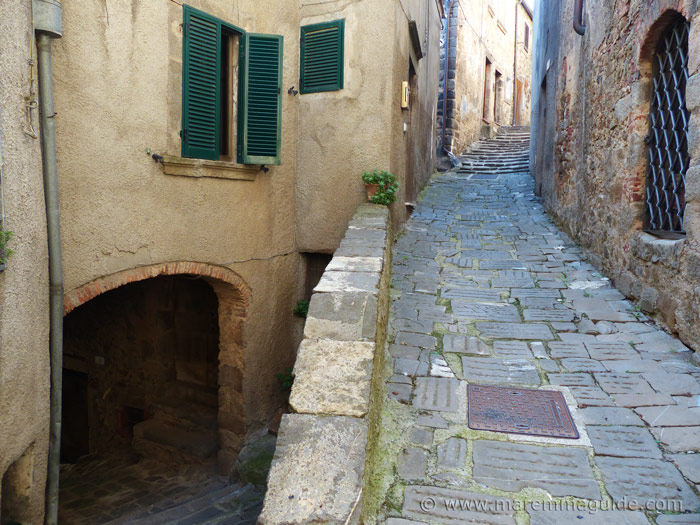
Doesn't this door fill you with wonder as to who once lived there? I would have to stoop ever so low to enter its threshold.
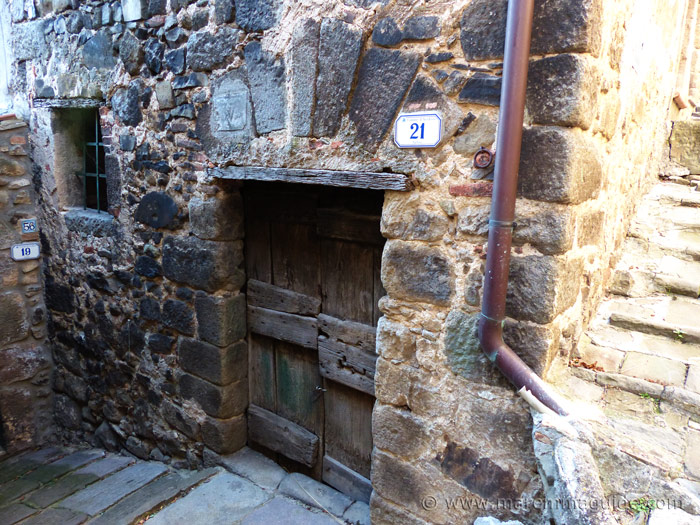
This narrow passage will haev you breathing-in!
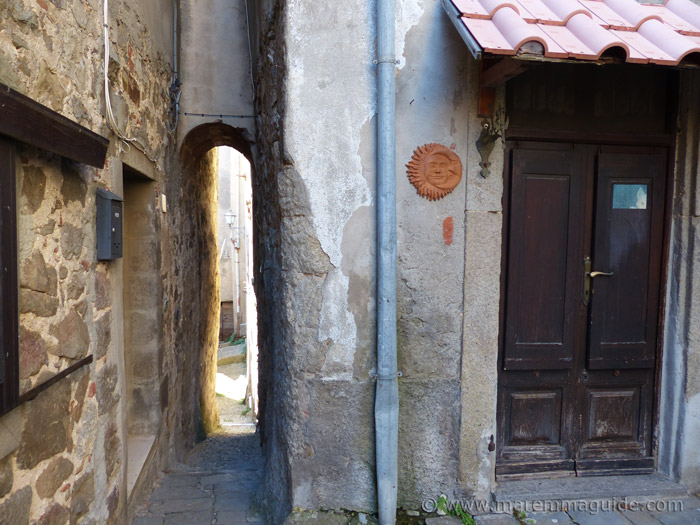
These ancient stone steps were built in this fashion to aid the horse-riding owner of this house mount their steed, or nag as was more probably the case.
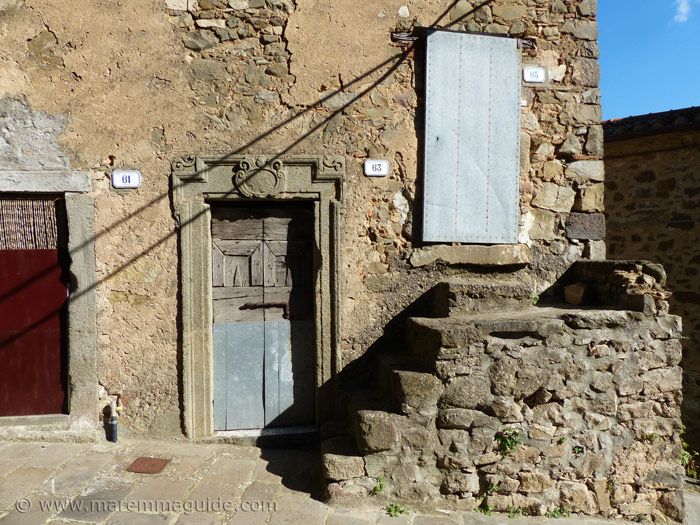
Don't forget to look up when you are out and about wondering in Maremma: there is always more to see!
Built upon the rock outcrop that protrudes in the centre of town, the arches and thickness of the walls of this building in Via della Porta - one of the original entrances into Montelaterone - are tell tale signs of its original defensive importance.
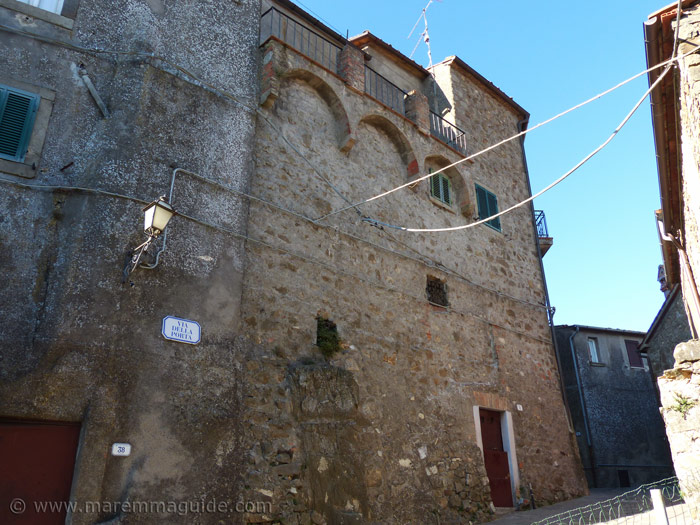
The juxtaposition of old and new, living alongside each other. Every hill top town in Maremma is the same. If you have the time to stop a while, you can trace the changes to the buildings over hundreds of years from the cut-off arch here, to the blocked-up window there. Each telling of a change of usage or the results of the imposition of a new tax.
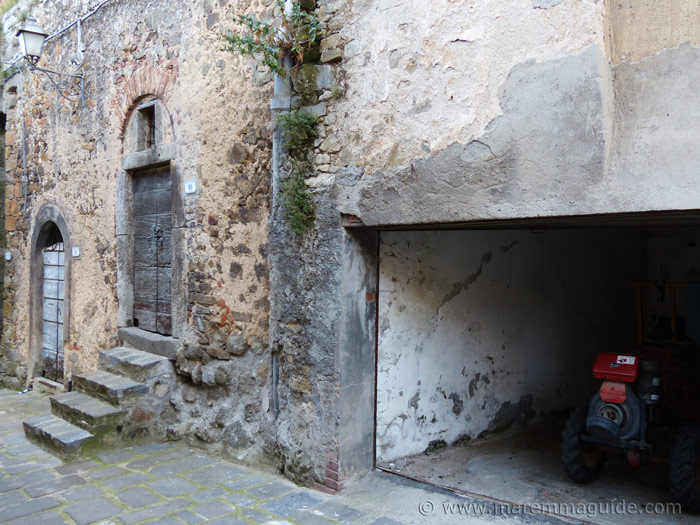
The Via d'Amore, the alley of love. Not sure that I would hover long there in the dark, but it makes for a great short-cut to the church and the bar.

And last but not least, Via del Popolo, taking me back to the bar and the centre of town. Just like the black cat in front of me.

The view outside of the medieval city gates and walls is green. Nothing but rolling hills of green.

The Cassero di Montelaterone - the fortress
Montelaterone's fortress dates back to the year 1262 and was built into the town's existing defensive double walls by the Republic of Siena. At that time, it was of fortification of vital importance to the Republic in their never ending wars with Maremma's Counts of Aldobrandeschi.
Its external walls are positioned at irregular angles one with another due to the topography of the bedrock below. But the internal, taller, tower at its centre is square-based. Accessible only from a stairway on its south-eastern side that led from the fortresses internal courtyard to the tower's first floor.

On the ground floor, between it and the fortress walls once stood another building that stretched around both the south-eastern and south-western sides. Its ground floor was home to billeted soldiers. Whilst the warmer and less rudimentary first floor was home to the lord of the castle and his family. Having explored the Cassero, I can say that it was a "snug" set of circumstances.
When most of Maremma became part of the property of the Grand Duchy of Tuscany in the 16th century, the Cassero di Montelaterone was no longer considered to be of any strategic importance and its structural decline began. Hastened by locals "recycling" its masonary for their own use. Recent conservation works have halted its decay to some extent.
If you have children with you, be aware that there isn't much else to "see", the internal grounds are spoilt by a degree of debris, and you can't climb the tower.
But it is for the view that you should walk to the Cassero at the top of town. Of Montegiovi and the Valley of the Golden Shell. The Val del Conca d'Oro.
This is just a small part.
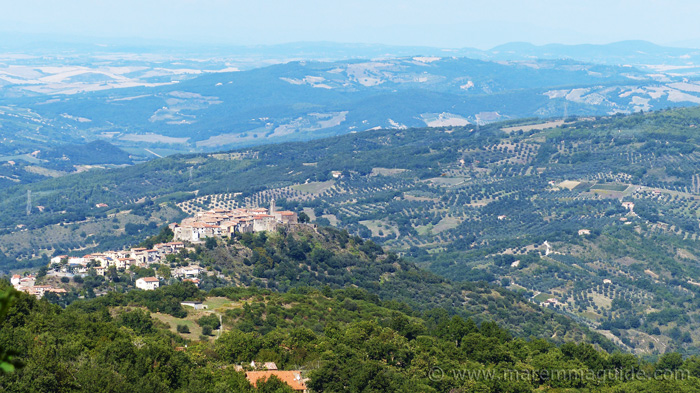
Explore some more...
















